|
TennisOne Lessons Framing Your Shots Doug King I want to examine the concept of “framing your shots.” No, I am not talking about spraying the ball off the racquet frame and sending it into the geraniums down by the clubhouse. I'm talking about creating a framework that provides the basic structure or form of a stroke. Although there are various relevant “forms” for the stroke (feet, body), I want to focus specifically on the relationship between the arms and the body and how this creates its own framework for good stroking technique.
But before we look at the method of developing more stroke structure, let’s examine the general purpose of structure in the stroke. Structure versus Flexibility Tennis is a highly demanding game in terms of coordination. It is based on trying to regulate a ball that is wildly irregular. To control the ball requires both tremendous uniformity and flexibility. To control the placement of the ball one must achieve near perfect timing and alignment between racquet and ball. Played at higher levels, the margins for error are very slim so there must be extraordinary precision required from the stroke time after time. On the other hand, because the ball is so unpredictable, the only way to adjust is to be constantly changing with it. Since everything is in a state of flux, the only way to survive is to adapt. The challenge is to learn how to integrate two elements (structure and flexibility) effectively into your game. In my article on Body Mechanics, I described how the human body is designed to produce both power and control. The legs and lower body create stability and ground force power while the upper body is more oriented to flexible, flowing, or whip like motion. This natural design can be utilized to advantage but it can also present problems. Because of this design, the natural inclination is to be too stable in the feet and legs while too whippy in the arms and hands. We must constantly train and remind ourselves to keep our feet moving, to stay light on the feet, to bend the knees. Whenever we get tired, or nervous, or want to focus more intently, or stroke with more power, our natural tendency is to plant the feet and stabilize the body.
Ballroom dancers hold their arms and upper bodies in a relaxed yet steady frame while the feet are light and active; a good recipe for tennis playing.
In the same way we have a tendency to get too whippy in the arms. Our natural tendency is to let the arms swing around too much. From a technical perspective, regarding the arms, one of the most common concerns is how to keep the stroke more compact and in sync with the body. So in this article we will look at how to develop an upper body framework that will keep the arms from getting too swingy and stay more connected to the body. In this way tennis is very much like ballroom dancing. The feet are kept light and moving while the arms and upper body form a relaxed frame that is fluid and yet stable. The “Unit Turn” and the “Unified Stroke” There has been, I believe, a general acceptance of what has been commonly referred to as the “Unit Turn.” The “Unit Turn” refers to keeping both hands on the racquet as the body makes its initial turn on the backswing. Instead of simply "racquet back," instructors are more conscious of understanding and explaining that racquet preparation must be done with "structure" or form, minimizing the risk of an impulsive, over-swing back of the arm and racquet. When the preparation is made with too abrupt or forceful of an arm extension, the stroke loses control, balance, and structure. When the turn is executed as a fully integrated movement involving arms and body together, the result is a movement with much more integrity. In the same way the entire stroke must have structure and form and we may similarly refer to this as a unit stroke, or a “unified stroke.” When the arms move in proper positions and sequence with the body there are numerous benefits. This unified stroke structure or form provides not only improved balance and coordination it also enhances power and consistency through proper timing and alignment. Power A unified stroke creates a basis of power by increasing the mass of the stroke, an element of the power equation. It is much like a football defender trying to tackle a runner from the side as opposed to directly in front of the runner. If the runner can get to the side of the tackler he will often be successful in breaking through a weaker “arm tackle.” The defender is much stronger and will offer more resistance if he can get lined up behind the runner instead of off to the side. In the same way a tennis player will be stronger if the body is lined up behind the shot rather than just making an “arm swing.“ Consistency Consistency can also come from structure as well. When there are fewer moving parts, it is easier to keep things in their place. When I can keep certain things in the same place, I can use those stable elements as reference points to other more moving things. I can gain awareness of the moving parts by referencing them against things that are not moving. I see and judge the flight of a moving ball by referencing it against things that don’t move - the net, the fence, the court. That is why it is difficult to judge high lobs in a clear sky - there is nothing to reference the ball to.
Perhaps the most devastating
groundies the women’s tour has ever seen, Seles uses solid stroke framing and powerful leveraged thrusts on the ball. Ultimately what we are after is stroking technique that synchronizes the movement from the outside edge of the stroke (the tip of the racquet) with movement from the center of the stroke (the core of the body) so that maximum efficiency is achieved. By maximizing efficiency you achieve the most power and control with the least amount of stress. "Framing" your strokes will help to achieve this unification and efficiency. Setting Up the Frame Every stroke begins with a set up or “ready position.“ In some respects this is the most important position in the game as it establishes the fundamental structure that every other position in the game is based upon. The proper position of the arms to the body at the set up should be a position of strength. If someone were to push against your racquet while it is in the ready position, the resistance that you could exert against that push would be strong. This is exactly what we ultimately try to duplicate when we establish our ideal contact position. This is called a leveraged position. Leverage is established when the body is set up to exert maximum force on another object, namely the ball. When the contact point gets away from this point of leverage, we are said to be “out of position.” The ready position establishes the “frame” of the stroke. With both hands on the racquet the arms form an enclosed form or frame with the body. This frame can be shifted around in various ways through different arm and body motions. The frame can be wound and unwound; it can be lifted and lowered, pushed away, pulled in, or moved in various combinations of all of these actions to create “shape.” Top players don’t “swing” their arm and racquet at the ball as much as they shift their entire frame into the ball. This is done by using the whole body; feet, knees, hips, shoulders, and arms.
Look at the example of Seles in the clip above. Of course a two handed player’s technique is based upon a “framing” principle. But notice the tremendous leverage that Seles exerts on her stroke by managing the contact point. She gets behind the ball and attacks it like an aggressive linebacker would tackle a ball carrier, using a powerful move from the body rather than a swing of the arm. The two handed technique is an almost foolproof way of integrating the arms and body. The arms have a much more difficult time getting disengaged from the body. Working the Frame Although the frame works as a unit it is also a pliable unit. A proper working stroking frame is a hinged frame and these hinges exist at the shoulders, elbows, and wrists. I can pull the frame into the body by bending the elbows and I can extend the frame by straightening the elbows. I can also hinge at the shoulders to open the frame and close the frame. Various strokes have different patterns of how to shift, rotate, and open and close the frame. One Handed Topspin Forehand Let’s take a few examples of how to work with a frame concept. We’ll start with the one handed forehand groundstroke (right handed) and use the Haas clip on the right as a classic example. The frame is held together while it is turned and lifted in the backswing (video1). Then the frame is tilted so the hitting side drops and at the same time the frame opens so that the hands are approximately four feet apart. The left arm extends out to the side fence and then out to the net (video 2). As the ball approaches the frame is rotated forward slightly and lifted into the ball (video 3). From contact on the ball, the right shoulder pushes the racquet out slightly to the target and then back into the left hand to close the frame slightly in front of the left shoulder (video 4). There are numerous interesting things you can diagnose by using the framing concept, especially from figure 2 to 3. Notice the arms are not actually swung out to the ball as much as the body is shifted to reposition the frame to the front of the body for proper leverage. If anything, the arms are pulled in closer to the body as they approach contact, what I call gathering the ball into contact. You can see both arms flex in as they approach contact rather than extend out. Also notice the way the arms are brought to the front is a rotation and also a slight retreat of the upper body to get behind the hands. This reveals two of the most common errors on the forehand side – swinging out at the ball with the arms at contact and leaning in front of the hands with the upper body at contact. Using the Hands and Spilling the Racquet Another thing to notice on the Haas clips of the topspin forehand is how the hand fluidly lets the racquet fold back as contact is approached. Although there is forward motion being generated by various body actions, the hand itself is actually letting the racquet become very neutral and thus stable as it approaches the ball, rather than active and “swingy” or wristy. The racquet “dies” back, or folds back into position to the forearm and the overall frame and into the contact of the ball (see contact point on Haas video 3).
You can see the tremendous leverage from the body position and the stored energy in the flex of the forearm at contact. Imagine the power that is released just from the spring out of the ball from this dynamic. This is what I sometimes refer to as letting the racquet spill back out of the hand and into contact, much like you would let a cup of water spill out of your hand behind your arm (see video 1 above). You can see this on all topspin strokes as illustrated in the examples in this article. So even though the frame is relatively unified, the hands can manipulate the racquet within the frame to change grips and wrist positions or to rotate the arm, and to add flow into the entire movement of the body and frame by creating slight delays and lags between the racquet and body. One Handed Backhand
From forehand to volleys and overhead Petrova’s feet stay light and her frame is held in position, much like a dancer.
The backhand is very similar to the forehand. The frame is held together as it is lifted and turned on the backswing. The frame is then dropped and tilted (back shoulder down) while the racquet is "spilled" back by the hand as contact is approached. Just as the butt of the racquet passes the front hip, and just a moment before contact, the frame is opened at the hinges in the shoulders. The racquet face is held steady while the frame is pulled open to the finish. The shoulders open (separate) as wide as possible and more quickly for maximum power, although the racquet head is still held in a relatively steady alignment through contact (minimum momentum in the tip of the racquet and maximum momentum in the handle of the racquet). Volleys And Serves The volleys are easy to translate into the framing model. Since we are encouraged not to swing on volleys and keeping our frame together will help us eliminate excessive swinging. Of course, I would suggest we don’t want to swing on any shots (I am quibbling semantics here - but words have impact). The volleys are really very much like the groundstrokes in principle. They typically require much less force (in fact in many instances they require removal of force) but the concepts of meeting the ball and pushing and turning the ball are the same.
Even on the serve we can use the principle of keeping a frame to the upper body. Many people overswing the racquet and this causes them to either pull the body down too early or to pull the arm into the body too close. If care is taken to keep the arms working together in a way that brings the racquet back into the original frame at the finish, this will help to maintain integrity to the stroke and avoid overswinging. Exercises There are many different ways to develop a better sense of framing. Simply holding the follow through and catching your racquet on the finish is a good technique. Using two hands on your strokes is also a useful drill. One of my favorites is to take a medium sized exercise ball (something that you can get your arms comfortably around) and try to hit balls that someone tosses to you. You can play both groundstrokes and volleys and this will help you get the feeling of maintaining a framework and developing a more unified stroke. When you use the large ball, keep it held to the body all the way from the start to finish on your forehand strokes. The same is true for your two handed strokes. For the one handed backhand strokes, the ball should be released just prior to contact. The ball should drop straight down in front of the body after you release it. Conclusion Certainly the concept of keeping the strokes compact or contained is nothing new. I’m sure that every coach has their own ways of trying to get players to get a more unified stroke, one that synchronizes weight shift with racquet movement. However, the model of constructing and manipulating a "frame" created by the arms and the upper body may be something that is useful in both getting the feel and to better understand the concept of a more unified stroke. Try it yourself and see if putting your strokes in a frame doesn’t help you get the picture. Your comments are welcome. Let us know what you think about Doug King's article by emailing us here at TennisOne.
Doug is one of the country's foremost tennis teaching innovators. Founder of Acceleration Tennis, a revolutionary teaching system, King is leading the way in reinterpreting the traditional tennis model. Doug King is currently Director of Tennis at Meadowood Napa Valley ( www.meadowood.com ), a Relaix Chateau Resort in St. Helena , CA . For more information on Acceleration Tennis please email Doug King at dking@meadowood.com. |

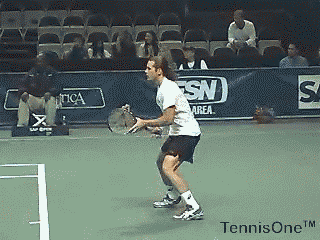
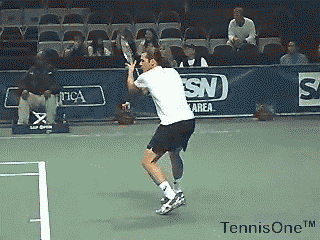
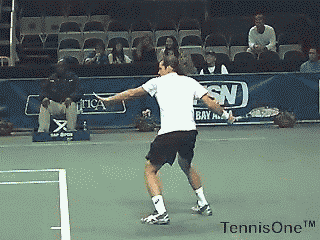
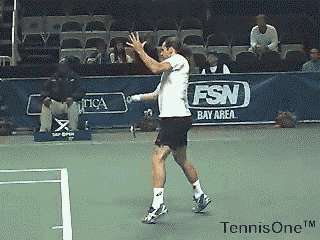
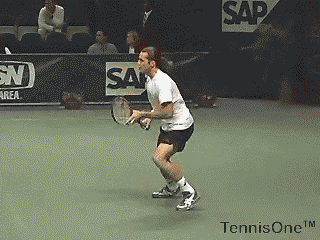
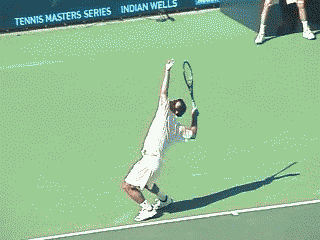
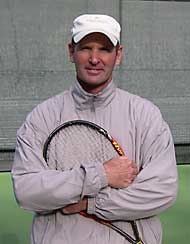
 Doug King studied with legendary tennis coach Tom Stow and was a
former California State Men's Singles Champion
and the former number one men's player of Northern California.
Doug King studied with legendary tennis coach Tom Stow and was a
former California State Men's Singles Champion
and the former number one men's player of Northern California.